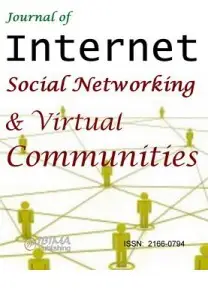Introduction
Tourism is already considered a phenomenon at the political, economic, environmental and sociocultural levels, and is no longer associated only with leisure. Given its importance for the economies of countries, this is a sector that must be considered and analyzed so that the best policies are adopted for its development.
Considering the growing importance of tourism, there is an increasing density of studies on the area and for this reason, its conceptualization has also undergone changes, also influenced by the development of the activity itself, as well as reflecting social, economic and structural changes that have been taking place. One of the main changes in relation to tourism has to do with the increasing influence of social networks, both in terms of tourist demand and in the offer and promotion of tourist destinations.
Since their appearance, social networks have had an enormous evolution, especially due to the emergence of Web 2.0. Unlike the previous version (Web 1.0), which was more directly related to information, Web 2.0 refers to users’ collaboration as mere recipients and to the Web community. Social networks can be broadly defined as sites and applications that allow users create and share content with networks (i.e. friends, followers, etc.). Currently, they are a persuasive phenomenon as they attract millions of people as a means of enhancing ubiquity. Nowadays social networks cover all social areas, such as economic, educational, political, financial, health, religious, etc., and tourism is, of course, no exception.
With this study we intend to analyze the image of the tourist destination Douro Vinhateiro through social networks, considering the perception of tourists. This tourist destination was chosen because it is one of the most emblematic Portuguese tourist destinations and with the most impacting image, being associated with several identifying elements, such as vineyards, the Douro river, farms, among others.
Literature Review
Tourist destination image
Tourism presents itself as an industry that sells fantasies, supports dreams, expectations, hopes, and allows confirmation of the constructed images of destinations (Gastal,2003; Martins, 2015). The idea that a picture is worth a thousand words has never been more appropriate and truer. It can even be said that images are a form of text intended to represent the real world, like paintings and writing (Balomenou & Gerrod, 2019; Jenkins, 2003). Text alone cannot register the experience of seeing, hearing, and smelling a landscape, unlike images that can convey these meanings in multiple layers. Thus, visual methods may be considered capable of eliciting inherent experiential qualities that words alone cannot (Balomenou & Gerrod, 2019).
At the level of the tourism industry, although tourists do not have a great deal of knowledge about destinations they have never visited, they are able to create an image in their minds, not only for ideal destinations but also for alternative destinations (Mayo, 1975). Tasci, Gartner e Cavusgil (2007) state that the basis of destination image is to find out how tourist destinations are seen and felt in the eyes of tourists. To Alcaniz, Garcia e Blas (2009), the destination image is a mental representation that the tourist forms in his mind, considering what he knows and feels about a destination. It is known that the concept of “image” remains complex and ill-defined, since several designations have been used to describe it such as: representation, ideas, beliefs, thoughts, feelings, object, impressions or identity (Matos, Mendes & Valle, 2012). Cardoso, Santana e Brea (2018) systematize the concepts presented in the tourism literature on the concept of destination image, as all the ideas, beliefs, impressions, perceptions and knowledge of a tourist about a tourist destination and that are stored in his memory. Cardoso, Vila, Araújo e Dias (2019) reinforce the concept and add the perception of tourists considering certain characteristics of the destination, such as infrastructure, hospitality, unique cultural attractions, among others. The tourist destination image is a strong predictor of tourists’ behavioral intention, such as the intention to visit/revisit the destination or to recommend it. Thus, different tourism organizations try to create a robust image for tourism destinations as a competitive factor. To identify the cause of destination image formation for visitors and non-visitors, it is vital to collect information (Yilmaz & Yilmaz, 2020).
Dimensions of the tourist destination image
For several authors, the destination image is created through emotional and rational interpretations of the consumer. Although there is no consensus in the definitions, a common aspect emerges among all of them, namely regarding the main dimensions of the destination image, which may contain functional, psychological, abstract or even more tangible characteristics (Baloglu & McCleary, 1999; Echtner & Richie, 2003). According to Jenkins (1999), the image of a destination is obtained through the association of impressions that an individual makes, which relate to the cognitive aspect, and on the other hand, emotions that relate to the affective aspect. Other authors, like Pike e Ryan (2004), have proposed a third component, the connotative/behavioral.
The cognitive dimension focuses on beliefs or knowledge about the attributes of a travel destination, such as the attractions and environment (Stepchenkova & Mills, 2010). In short, it is what the tourist thinks or believes he/she knows about the destination. The affective dimension refers to the feelings or emotions associated with a destination, such as the fact that it is pleasant or exciting (Kim & Richardson, 2003; Seo & Yun, 2015; Toudert & Rábago, 2019). Gartner (1993) mentions that this component is the value that each individual attributes to the destination, based on his or her own motivations. In the view of Gartner (1993) and Woodside and Lysonski (1989), the image of the destination presents the sequence from the cognitive to the affective, that is, in a first moment there are the beliefs, which passed in a second moment by an emotional reaction. For Jenkins (1999), the image of the destination is originated due to an association of impressions, knowledge that is the result of the cognitive dimension and emotions of the affective dimension, which are developed about a particular destination by the person. Finally, the connotative dimension of the destination image is related to the tourist consumer’s actions, namely with regard to behavioral intention, the probability of returning or recommending the destination (Hallmann, Zehrer, & Müller, 2015; Konecnik & Gartner, 2007; Pike & Ryan, 2004; Stepchenkova & Mils, 2010). The connotative dimension is also responsible for tourists evoking the attributes of the destination in their memories (Cardoso & Brea, 2012) and for tourists verbally sharing relevant aspects of their visit to the destination (Akdag, Guler, Dalgic, Benli, & Cakici, 2018).
Tourist destination image and social networks
With the evolution of the digital world, the tourism industry has enjoyed benefits (Gouveia, 2018) and has allowed consumers to access the opinions of other people, who have experienced a particular experience, visited a destination or may have used a specific product (Pan, MacLaurin, & Crotts, 2007). Thus, the consumer himself not only saves time in decision making, but also makes more assertive decisions by the availability of information on online platforms, and most of the time, these platforms are the “eyes” and “ears” of the tourist (Hennig-Thurau & Walsh, 2003; Marujo, 2008).
The “screen time” consumed by people on online platforms is leading to their “beliefs, ideas and impressions” that consequently originate the destination image, now being formed by the publications, images and videos that are consumed online (Xiang & Gretzel, 2010). To Hunter (2016), the individual thus became responsible for the projection or representation of the destination image. In this way, the link between the Internet and destination image becomes even more relevant, because the use of the Internet makes it possible not only to access destination image but also to influence it (Oliveira & Panyik, 2015).
The way in which the destination image is promoted in online channels is decisive for the tourist’s decision making (Marujo,2008), namely, in the Internet and social networks, enabling the creation of a virtual experience (Wong, Kler & Sondoh, 2017). The emergence of social networks has made it possible for tourists to share their experiences in real time at the destination itself, to follow the experiences of others, giving this content credible recognition for being an authentic experience (Zeng & Gerritsen, 2014; Kiráľová & Pavlíčeka, 2015; Chung & Koo, 2015). Any person has an inherent ability to construct a mental image, of any destination, without ever having been there. Thus, the process of formation implies that there is construction, modification, deconstruction and reconstruction of the image (Croy & Wheeler, 2017). Considering that the destination image goes through a continuous evolution, information sources act independently or together, in order to create a single mental image (Minni & Lubbe, 2017). Thus, people’s interaction with content found on social networks, such as visual images and narratives, not only allow them to obtain information, but also to create fantasies and dreams about the places portrayed, generating involvement and consumption from a mere representation (Minni & Lubbe, 2017). Tourist destination managers must adjust their strategies to this new digital communication channel, given the intrinsic ability of social networks to influence the construction of the destination’s image (Buhalis & Law, 2008; Minni & Lubbe, 2017).
Methodology
In this study, we opted at first for a qualitative approach, where we analyzed some pages of social networks about the Douro, namely, the first results of the research that were not hotels or other types of accommodation, but travel agencies and pages promoting the Douro, in order to collect the main elements that build the image of the Douro; and a quantitative analysis, using questionnaires, in order to assess the image and their perception of the Douro as a tourist destination with tourists in this region.
For the elaboration of the questionnaire, it was necessary to use the dimensions found in the qualitative analysis. In this sense, an exploratory study was carried out with the search for “Douro Facebook” in the Google search engine. Following up on the social network Facebook, looking for “Douro Turismo”, which resulted in several pages. Of the numerous pages found, four were chosen, giving priority to the variety of photographs published in them, since the more elements associated with the image, the more complete the analysis would be.
In the quantitative methodology through a questionnaire survey, the main methodological elements are described in Table 1. The statistical analysis of the data was performed using the statistical software IBM SPSS Statistics, version 28.
Table 1: Summary of the survey
Presentation and Discussion of Results
In this section, the results of the qualitative and quantitative analysis will be presented and discussed.
Presence of Douro Destination on social networks
By consulting the publications made on the pages of Facebook, we verified the existence of a set of dimensions associated with the Douro Image. Then will be presented the most evident dimensions of each of the analyzed pages.
Roteiro do Douro
The Roteiro do Douro concerns a Tourist Guide for the Douro responsible for gathering all tourist information about the Douro region: itineraries, cruises, accommodation, restaurants and much more, also providing information about programs and tourist circuits in the region, collaborating with several local partners. As far as visual elements are concerned, the Facebook Roteiro do Douro focuses on photos taken by several authors, promoting the idyllic landscape of this region, with the Douro river, the emblematic Douro line and the vineyards as the main protagonists (Figure 1). Another element of the visual elements related to this destination tourism concerns the city of Porto, that is, with the mouth of the Douro River and its UNESCO heritage landscape, Ribeira do Porto, and the farms and bridges are also elements present in the photographs included in the Roteiro do Douro Facebook. Another important element has to do with cruise ships, as this is a page that, among other things, promotes cruises on the Douro River (Figure 1).

Figure 1. Images shared by the Roteiro do Douro
The image of the Douro destination, according to the social networks of the company “Roteiro do Douro” is made up of several elements, such as: the Douro River, the vineyards where Port wine and the famous Douro wines are produced, the line of Douro train, river cruises, wine estates, bridges over the Douro River and the city of Porto, as a beginning or end point of the trip through the Douro, with Ribeira as the main postcard
Douro Acima
Douro Acima is a tourism company, specialized in cruises on the Douro River. The Facebook page provides information about the company’s offers, accompanied by images alluding to the main attractions of the Douro. As far as visual elements are concerned, the Facebook Douro Acima, and considering the scope of activity of the company, it is possible to verify that these are centered, naturally, in the Douro River, in its bridges and in the surrounding river, or in the Douro Wine Region as well as in the City of Porto, with emphasis on Ribeira. Thus, as can be seen in Figure 2, there are several visual elements that, after analyzing the Facebook page of Douro above, can be associated with the image of tourism in the Douro: The Douro River, the Ribeira do Porto, the Rabelo boats, the bridges in the city of Porto, the landscapes of the Douro Wine Region and the wines.
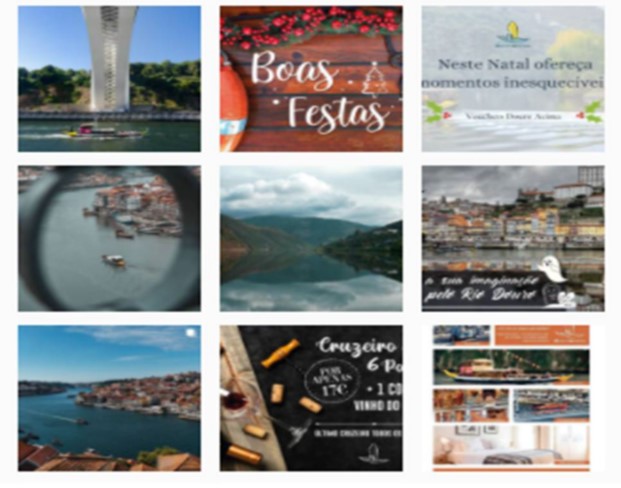
Figure 2. Images shared by Douro Acima
Rota do Douro
The company Rota do Douro carries out cruises on the Douro River lasting several days, departing from Cais de Gaia and up the river to the landscapes of vineyards of the Douro Vinhateiro. This page, in addition to being a complement to the website, gives also the possibility of making the markings directly on the various cruises that are offered by the company. With a very modern image, the Douro Route includes in its image identifying elements of the Douro region, where the city of Porto, the Douro River and the landscape from the vineyards of the Douro River. Also noteworthy is the Port Wine, product of excellence in this area, recognized worldwide (Figure 3).
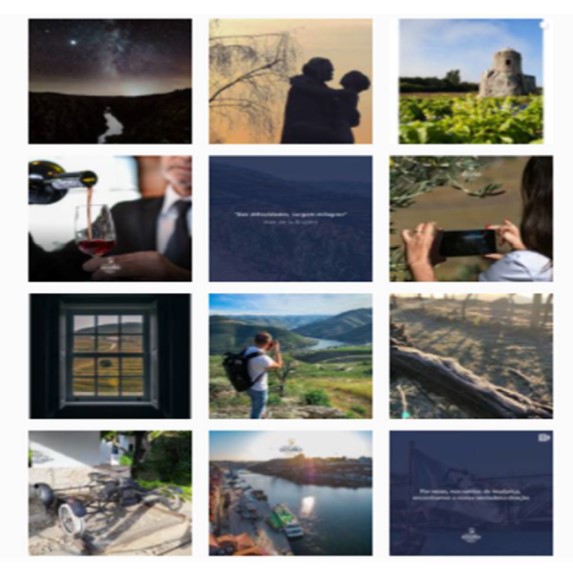
Figure 3. Images shared by Rota do Douro
I Love Douro
I Love Douro is a page to promote the Douro, World Heritage since 2001, being therefore an important tourism tool in terms of advertising of this region. This is, therefore, a page where the image of the Douro destination acquires a special importance, in order to communicate to the public the main attractions of the region. The photos posted on the Facebook page are particularly beautiful and studied to better enhance the beauties of this region. The vineyards and the Douro river appear as the main elements of publicizing this tourist destination (Figure 4).
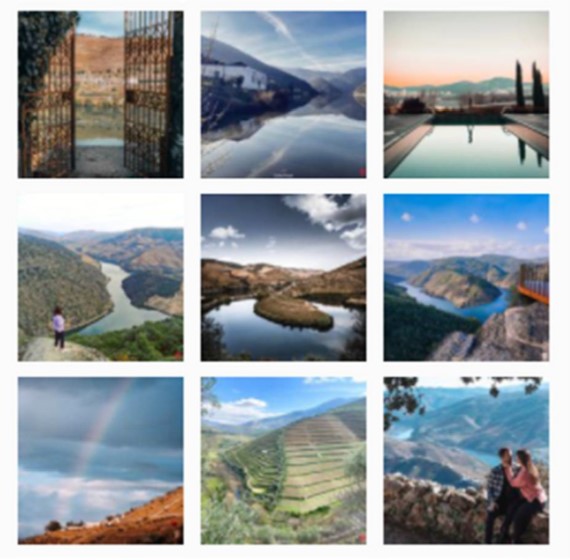
Figure 4. Images shared by I Love Douro
By analyzing the pages previously presented, we can conclude that the image of the Douro is associated, mainly in three dimensions: the Douro River, the Vineyards and the Porto city. Within these dimensions, other associated dimensions with the image of tourism in the Douro are:
- Ribeira do Douro;
- Douro River Bridges;
- Port Wine;
- Wine farms;
- Douro Train Line;
- Boats, with special emphasis on Rabelos Boats.
Presence of the Douro destination in the minds of visitors
In the characterization of the sample (Table 1), it is observed that the sample consists of 315 individuals. With regard to the personal characterization of the respondents, the majority of the sample is female (n=175, 55.6%), with 140 being male (44.4%), and mostly young, of the 18 aged 35 (n=266, 84.4% and single (n=252, 80.0%). Regarding the country of origin, respondents are predominantly Portuguese (n=276, 87.8%), and residents in the district of Bragança (n=177, 56.2%). As for the academic qualifications of the participants, it appears that most have higher education (n=223, 70.8%).
Table 1 – Sociodemographic Characterization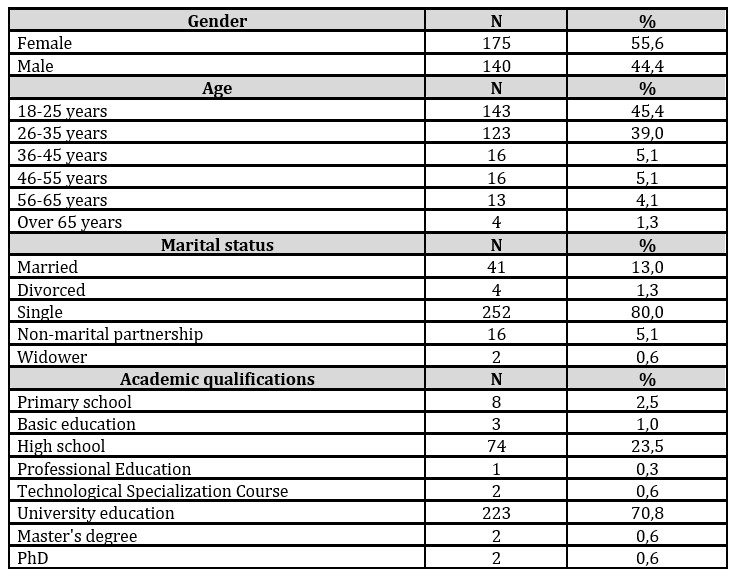
Of the respondents who reported having visited the Douro Region, it was found that the main reason for the visit was tourism/leisure (n=230, 73.0%), followed by visiting family/friends (n=48, 15.2%), and business (n=7, 2.2%). The option that allowed giving another answer was pointed out by five respondents, in which they specified study visits, baptisms and living in the region. Of the people who have not yet visited the region (n=25), the reasons given are the lack of opportunity.
As for the attributes of the Douro Region that may have influenced the respondents’ visit, the results are shown in Figure 5. For most of the sample, the natural and scenic beauty of the region (n=308, 97.8%) is the predominant attribute that could influence the visit, followed by gastronomy (n=192, 61%), wine tourism/wines (n=170, 54%), and culture/history (n=150, 47.6%). The attributes with the lowest incidence are the receptivity of the local community (n=53, 16.8%) and tourist entertainment (n=32, 10.2%).
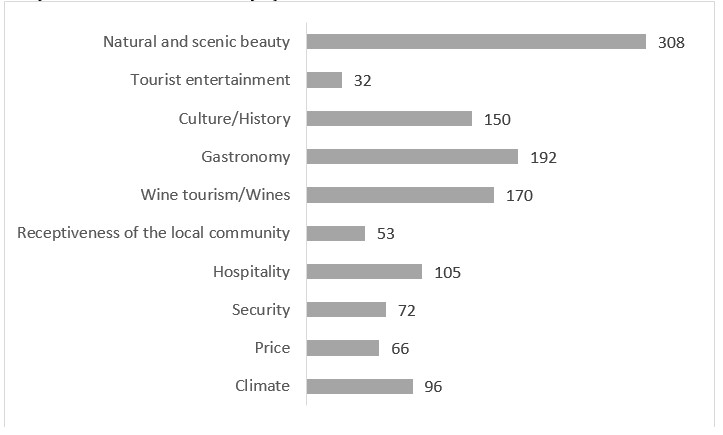
Figure 5. Attributes of the Douro Region that can influence the visit
Since the Douro Region is well known for its wines and its tourism related to vineyards and wine, it was decided to cross-reference the results of the wine tourism/wines attribute with other attributes of the region. The results are shown in table 2. It is observed that of the respondents who feel influenced by wine tourism/wines on a visit to the Douro, 97.7% (n=167) also mentioned that the attribute “natural and scenic beauty” influences them. By applying Fisher’s exact test, since the assumption of the expected frequency of the chi-square test was not verified, it was concluded at a significance level of 5% that these attributes are not significantly associated. Therefore, it can be said that the visit to the Douro influenced by the natural beauty of the region is not associated with the visit to the Douro influenced by wine tourism/wines. Relating the respondents who mentioned wine tourism/wines with culture/history as an attribute of influence in the visit to the Douro, it is observed that around 50.0% (n=86) of those who had been influenced by wine tourism/wines also mentioned the culture/history attribute. By applying the chi-square test, it was concluded at a significance level of 5% that these attributes are not significantly associated. Therefore, it can be said that the visit to the Douro influenced by the culture/history of the region is not associated with the visit to the Douro influenced by wine tourism/wines. Regarding the intersection of wine tourism/wines with gastronomy, it is observed that of the 171 respondents who chose wine tourism/wines, 71.3% (n=123) chose gastronomy. By applying the chi-square test (χ=17.913; ρ=0.000), it was concluded that these two attributes are statistically related. With regard to hospitality, this attribute was mentioned by 105 of the respondents, and of these, 69 also mentioned wine tourism/wines. By applying the chi-square test (χ=8.289; ρ=0.006), it was concluded that these attributes are statistically associated. On the other hand, it was concluded at a significance level of 5% that the attributes price of the tourist region of Douro and climate of the region were not statistically associated with the attribute wine tourism/wines as attributes that influence a visit to the Douro.
Table 2: Relationship of the wine tourism/wines attribute with other attributes of the Douro region
n – observed frequency; p – proof value; a – Chi-square test application; b– Fisher exact test application; *- significant at 5%; **- significant at 1%.
In order to analyze the perception that respondents have about the Douro Region as a destination to visit, a set of questions were analyzed on a 5-point Likert-type agreement scale (1- Strongly disagree to 5- Strongly agree). With the analysis of table 3, the characteristics attributed to the Douro Region as a visiting destination are identified. Thus, it appears that a large number of respondents:
- Totally agree that the Douro Region is a safe region, rich in landscapes, with unique beauty scenarios and good gastronomy.
- Agree that the Douro Region enjoys quality infrastructure, with good accessibility, and a pleasant climate. It presents variety not only when it comes to the choice of accommodation, but also in restaurants, cultural attractions and regional products. Finally, it has hospitable inhabitants and a good tourist information network.
- Are indifferent to the fact that the Douro Region is an expensive region or that it has quality public transport
Table 3: Features of the Douro Region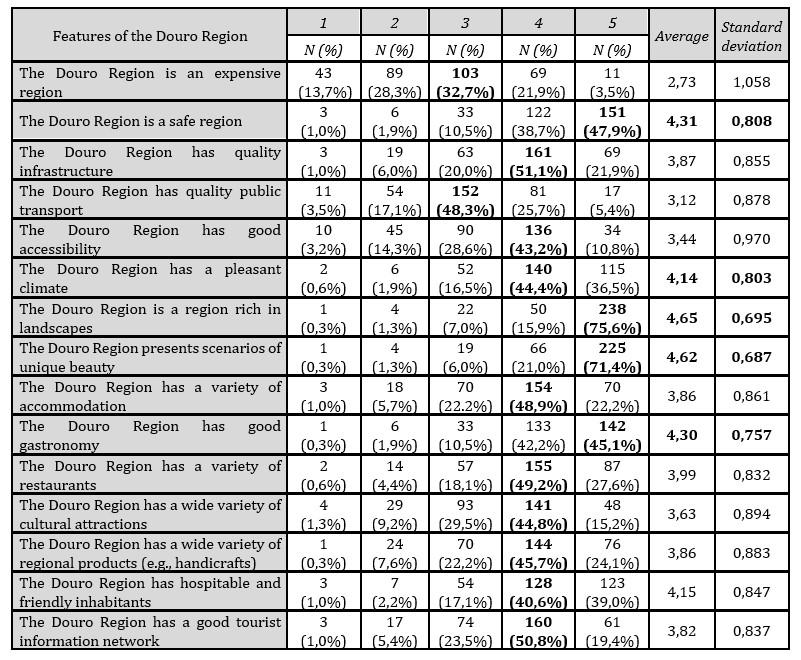
Considering the results presented, four dimensions were identified: accessibility, natural conditions, infrastructure and tourist offer, which allow a more detailed analysis of the quality of the region. Therefore, after analyzing the internal consistency of the various dimensions through Cronbach’s alpha coefficient, the four dimensions with the best indicators were identified. Therefore, the values of each dimension can vary between a minimum of 1 and a maximum of 5, with the higher the more relevant the quality factor being analyzed. By analyzing Table 4, it can be seen that the dimensions have good internal consistency, since the lowest Cronbach’s alpha coefficient is 0.733 in the accessibility dimension. It is observed that all dimensions present average values greater than three (theoretically expected value), which reveals at least satisfactory quality of the factors under analysis. Therefore, an average of 3.46 was obtained for the accessibility dimension in the Douro, corresponding to a standard deviation of 0.724, the lowest average result of the four dimensions. In the case of natural conditions, the highest average value was obtained, 4.47 (standard deviation of 0.654), which makes this dimension one of the strong points of the region, with a Cronbach’s alpha coefficient that presents a good indicator and the highest of the four variables. In the infrastructure dimension, an average of 3.90 (standard deviation of 0.710) and in the tourist offer of 3.98 (standard deviation of 0.656) was obtained, with both dimensions having an acceptable Cronbach’s alpha coefficient of 0.784 and 0.778, respectively.
Table 4: Characterization of the quality of the Douro region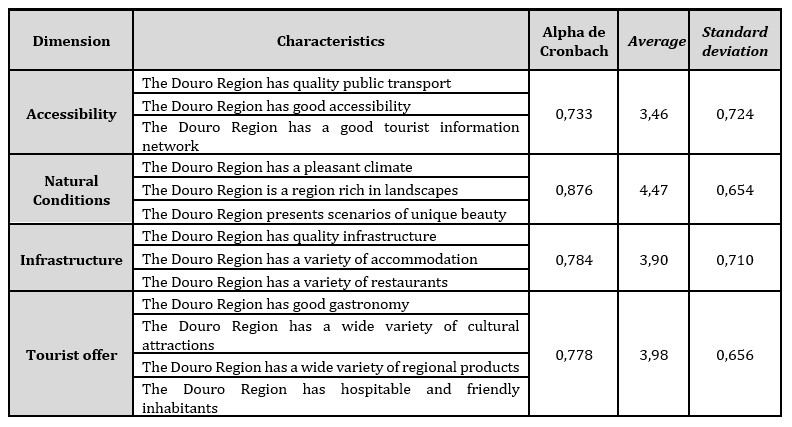
Study participants were asked about their mental association with the Douro Region (Figure 6). The dimensions associated with this question, and in a closed answer, resulted from the qualitative exploratory analysis of the present study. It appears that the main associations of respondents when thinking about the Douro Region correspond to the Douro River (n=256, 81.3%), to farms/vineyards (n=240, 76.2%) and to Port wine (n=204, 64.8%). On the other hand, biodiversity (n=1, 0.3%), bridges (n=63, 20%) and the city of Porto (n=73, 23.2%) are the least frequent associations.
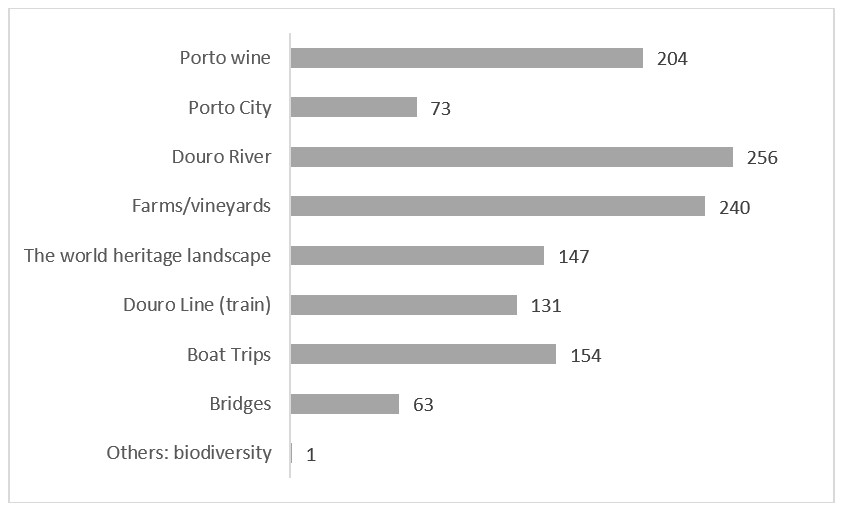
Figure 6. When you think about the Douro region, what associations do you make?
Through the crossing of variables and the chi-square test, we tried to analyze the possible relationship between the respondent’s gender, age and educational qualifications and the associations he makes when he thinks about the Douro Region. Tables 5, 6 and 7 present the results of the respective analysis.
From the analysis of table 5, it was concluded that the associations made by the respondents when they think about the Douro region present values of the tests, chi-square and Fisher’s exact test statistically independent of gender.
Table 5: Relationship between gender and the dimensions of the Douro Region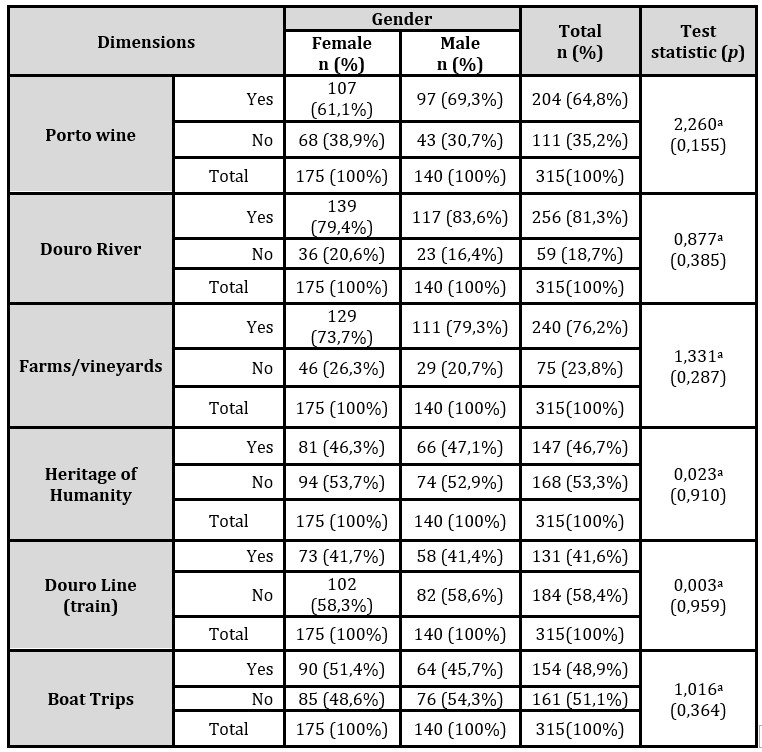
n – observed frequency; p – proof value; a – Chi-square test application; b– Fisher exact test application; *- significant at 5%; **- significant at 1%.
Table 6 shows that farms/vineyards are statistically associated with the age of the respondent. The remaining associations that respondents make when thinking about the Douro Region are not statistically related to age.
Table 6: Relationship between age and the dimensions of the Douro Region
n – observed frequency; p – proof value; a – Chi-square test application; b– Fisher exact test application; *- significant at 5%; **- significant at 1%.
From the analysis of table 7, it can be concluded that the associations made by the respondents when they think about the Douro Region are at a significance level of 5%, statistically independent of their educational qualifications.
Table 7: Relationship between educational qualifications and the dimensions of the Douro Region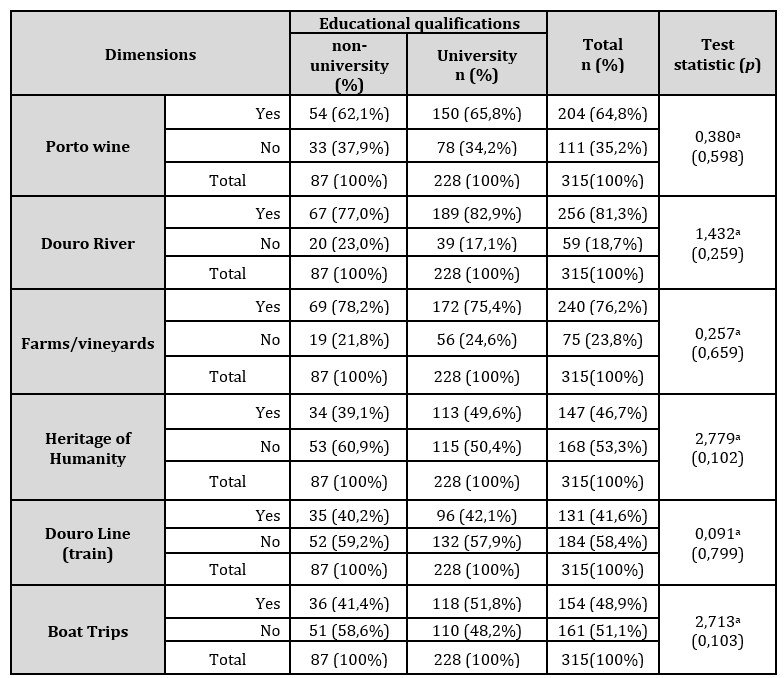
n – observed frequency; p – proof value; a – Chi-square test application; b– Fisher exact test application; *- significant at 5%; **- significant at 1%.
The sample was also asked about the use of social networks to choose the destination of their trips, and it was observed that the majority affirmed that they chose their trips through social networks (n=202, 64.1%), with the remaining members of the sample answering in the negative. The most frequently consulted social networks for finding information are Facebook and Instagram, however, they also make reference to YouTube, Twitter, WhatsApp, Reddit, Google Travel, and LinkedIn. The photos, videos and comments influenced the image of the Douro Wine Region, especially the positive comments, and the photos and videos of experiences and landscapes associated with the main elements of this destination, such as the Douro River, the vineyards, the farms, the wine, the city of Porto and its emblematic bridges.
Discussion and Conclusions
The main goal of this study was to analyze the image that the Douro Wine Region has in social networks, from the perspective of visitors. Considering the results obtained, from the qualitative analysis it was concluded that all the analyzed pages present contents of the Douro Wine Region image, associated to three main dimensions: i) the Douro River; ii) the Vineyards; iii) the city of Porto. Other dimensions are identified, namely: Douro River; Bridges of the Douro River; Port Wine; Wine Estates; Douro Train Line; Boats, with emphasis on the Rabelo Boats.
Regarding the results of the quantitative analysis, of the 290 visitors who have already visited the Douro Wine Region, the reasons for recurrence are tourism/leisure, visiting family/friends, and business. Of the region’s attributes that influenced the visit, the natural and scenic beauty, gastronomy, wine tourism/wine, and culture/history stand out. As for visitors’ perceptions of the Douro Wine Region, the respondents consider the region to be safe, rich in landscapes, with uniquely beautiful scenery and good food. They also point out quality infrastructures, with good accessibility, and a pleasant climate. The region also presents a variety in accommodation, restaurants, cultural attractions and regional products, not forgetting the hospitality and a good tourist information network. Thus, four dimensions associated with visitor perceptions were identified: accessibility, natural conditions, infrastructure, and tourism supply. The participants in the study identified the dimensions they mentally associate with the Douro Wine Region. The various options for dimensions result from the qualitative exploratory analysis of this study. It can be seen that the respondents’ main associations when thinking about the Douro Region are the Douro River, the farms/vines, and Port Wine. It is concluded that the dimensions that contribute to the overall image of the Douro destination are the cognitive, which include elements that identify this destination, such as the Douro River, the Vineyards, Port Wine, the city of Porto, and the affective, related to the good experiences that tourists have of this destination, its people, its accommodations, its culture, among others. The results confirm that social networks play an active role in shaping the image of tourist destinations, and can be important tools for increasing loyalty and, consequently, for developing a strong relationship between the visitor and the destination.
In carrying out any scientific work, there are limitations. The main limitation of the present study comes down to the methodology of applying the data collection instrument. In the initial phase of the empirical work, it was considered to apply the questionnaires to visitors, in person, at strategic locations in the study region. Considering the covid-19 pandemic situation, the methodology was readjusted with the implementation of online questionnaires. Collecting the data in this format conditioned the study sample and probably the information collected.
References
- Akdag, G., Guler, O., Dalgic, A., Benli, S., & Cakici, A. (2018). Do tourists’ gastronomic experiences differ within the same geographical region? A comparative study of two Mediterranean destinations: Turkey and Spain. British Food Journal, 120, 158-171.
- Alcaniz, E., Garcia, I., & Blas, S. (2009). The Functional-psychological Continuum In the Cognitive Image of a Destination: A Confirmatory Analysis. Tourism Management 30, 715-723.
- Baloglu, S., & McCleary, K. (1999). A model of destination image formation. Annals of Tourism Research 26(4), 868-897.
- Balomenou, N., & Gerrod, B. (2019). Photographs in tourism research: Prejudice, power, performance and participant-generated images. Tourism Management 70, 201-217.
- Buhalis, D., & Law, R. (2008). Progress in information technology and tourism management: 20 years on and 10 years after the Internet – The state of eTourism research. Tourism Management, 29(4), 609-623.
- Cardoso, L., & Brea, F. (2012). Medição da Tourism Destination Image: implicações para os markters do destino turístico. XVII Congresso AECIT (Associação Espanhola de Especialistas Científicos em Turismo), (pp. 1-16).
- Cardoso, L., Santana, L., & Brea, J. (2018). La Imagen del Destino Turístico. Em L. Cardoso, & F. Dias, La Imagen y la Promoción de los Destinos Turísticos (pp. 101-129). Espanhã: Editorial Aranzadi, S.A.U.
- Cardoso, L., Vila, N., Araújo, A., & Dias, F. (2019). Food tourism destinations’ imagery processing model. British Food Journal, 1-55.
- Chung, N., & Koo, C. (2015). The use of social media in travel information search. Telematics and Informatics, 215-229.
- Croy, G., & Wheeler, F. (2017). Image Formation: A Research Case. Em C. Hall, In Introduction to Tourism in Australia: Development Issues and Change. Frenchs Forest: Pearson Education.
- Echtner, C., & Ritchie, J. (2003). The Meaning and Measurement of Destination Image. Journal of Tourism Studies 14(1), 37-48.
- Gartner, W. (1993). Image formation process. Journal of Travel and Tourism Marketing 2(2/3), 191-215.
- Gastal, S. (2003). Turismo na Pós-modernidade: agregando imaginários. Em G. S, & A. Castrogiovanni, Turismo na pós-modernidade: (des)inquietações (p. 57). Porto Alegre: Edipicurs.
- Gouveia, M. (2018). Marketing Digital no Turismo. Obtido de MarcGouveia: https://www.marcogouveia.pt/marketing-digital-turismo/
- Hallmann, K., Zehrer, A., & Müller, S. (2015). Perceived Destination Image: An Image Model for a Winter Sports Destination and Its Effect on Intention to Revisit. Journal of Travel Research, 54(1), 94-106.
- Hennig-Thurau, T., & Walsh, G. (2003). Electronic Word-of-Mouth: Motives for and Consequences of Reading Customer Articulations on the Internet. International Journal of Electronic Commerce, 8(2), 51-74.
- Hunter, W. (2016). The Social Construction of Tourism Online Destination Image: A Comparative Semiotic Analysis of the Visual Representation of Seoul. Tourism Management 54, 221-229.
- Jenkins, O. (1999). Understanding and Measuring Tourist Destination Images. International Journal of Tourism Research 1, 1-15.
- Jenkins, O. (2003). Photography and travel brochures: The circle of representation. Tourism Geographies 5(3), 305-328.
- Kim, H., & Richardson, S. (2003). Motion picture impacts on destination images. Annals of Tourism Research 30(1), 216-237.
- Kiráľová, A., & Pavlíčeka, A. (2015). Development of Social Media Strategies in Tourism Destination. 3rd International Conference on Strategic Innovative Marketing (pp. 358-366). Madrid: Elsevier, Ltd.
- Konecnik, M., & Gartner, W. (2007). Customer-based Brand Equity for a Destination. Annals of Tourism Research 34, 400-421.
- Martins, M. (2015). The tourist Imagery, the Destination Image and the Brand Image. Journal of Tourism and Hospitality Management 3(2), 1-14.
- Marujo, M. (2008). A Internet como novo meio de comunicação para os destinos turísticos: o caso da Ilha da Madeira. Revista Turismo Em Análise, 19(1), 25-42.
- Matos, N., Mendes, J., & Valle, P. (2012). Revisiting the destination image construct through a conceptual model. Dos Algarves, 21, 101-109.
- Mayo, E. (1975). Tourism and the National Parks: A Psychographic and Attitudinal Study. Journal of Travel Research 14, 14-21.
- Minni, P., & Lubbe, B. (2017). The Role of te Media in Constructing a Destination Image: The Kenya Experience. Communication, 58-79.
- Oliveira, E., & Panyik, E. (2015). Content, context and co-creation: Digital challenges in destination branding with references to Portugal as a tourist destination. Journal of Vacation Marketing 21(1), 53-74.
- Pan, B., MacLaurin, T., & Crotts, J. (2007). Travel Blogs and the Implications for Destination Marketing. Journal of Travel Research, 46, 35-45.
- Pike, S., & Ryan, C. (2004). Destination positioning analysis through a comparison of cognitive, affective and conative perceptions. Journal of Travel Research 42(4), 333-342.
- Seo, S., & Yun, N. (2015). Multi-dimensional scale to measure destination food image: Case of Korean food. British Food Journal, 2914-2929.
- Stepchenkova, S., & Mills, J. (2010). Destination Image: A meta-analysis of 2000-2007 research. Journal of Hospitality Marketing & Management, 575-609.
- Tasci, A., Gartner, W., & Cavusgil, S. (2007). Measurement of Destination Brand Bias Using a Quasi-experimental Design. Tourism Management 28, 1529-1540.
- Toudert, D., & Rábago, N. (2019). Destination food image, satisfaction and outcomes in a border context: Tourists vs. excursionists. British Food Journal, 121, 1101-1115.
- Wong, S., Kler, B., & Sondoh, S. (2017). How Bloggers Use Geography to Develop Online Destination Image for Malaysian Borneo. Journal of Tourism, Hospitality & Culinary Arts, 9(3), 67-84.
- Woodside, A., & Lysonski, S. (1989). A General Model of Traveler Destination Choice. Journal of Travel Research 27, 8-14.
- Xiang, Z., & Gretzel, U. (2010). Role of social media in online travel information search. Tourism Management, 179-188.
- Yilmaz, Y., & Yilmaz, Y. (2020). Pre- and post-trip antecedents of destination image for non-visitors and visitors: A literature review. Journal of Tourism Research, 1-18.
- Zeng, B., & Gerritsen, R. (2014). What do we know about social media in tourism? A review. Tourism Management Perspectives, 10, 27-36.



